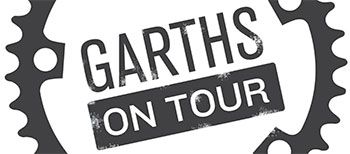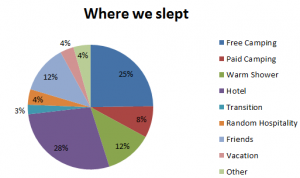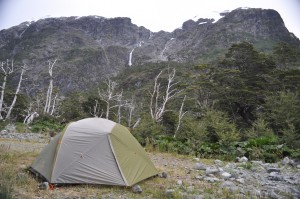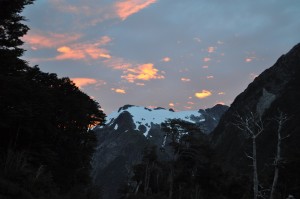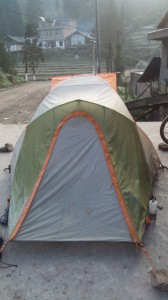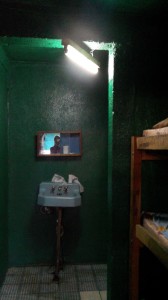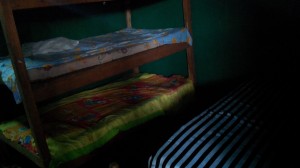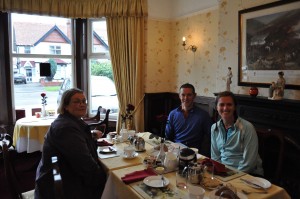This is part 1 of a two-part series. There’s so much to be said about planning for sleeping and the actual execution thereof on a bike tour. So, in this first post, for those who are generally curious, we’re going to give a breakdown of the places we slept on our world tour. Next week, for round two, we want to provide a resource and guide for other cyclists or bike tour planners as to strategies for lodging and how to maximize what’s available in different regions.
Part 1: A Summary of Sleeping Arrangements
Free camping: Anytime we used our tent without paying for the spot we used it. (The one exception would be a few of the warmshowers where we camped.) Free camping could be under a pavilion behind a church or in a town park, tucked into the trees in a roadside forest, or right out in the open in a desolate stretch of desert.
Paid camping: In most cases, this meant an organized campground, although in a few instances, we offered someone money to camp somewhere we perceived to be safe, perhaps behind a business or in a warehouse.
Warm Showers: We can’t say enough good things about warmshowers.org–the amazing hospitality network for touring cyclists. Hosts sign up to offer accommodation for people on bike tours—and it can range from camping in their backyard, to sleeping on the floor in the den, to being given the guest bedroom suite. We experienced all levels of hospitality from amazing hosts around the world, many of whom were fellow touring cyclists who had been on their own journeys.
Hotel: This might actually be the broadest category. We classify any indoor, paid accommodation as a hotel. That includes the somewhat-posh Galaxy Hotel with its massive buffet breakfast in Kabala, Greece, to the tiny, concrete room with a bucket scoop shower and squat toilet in the middle of nowhere, Cambodia. Prices ranged from $5 (in developing countries) to $79 (the most we ever personally paid for a room in the U.S.)
Transition: In all our travels, we spent many nights in transit. So this category includes every night we slept on an airplane, boat, bus or train. It also includes every airport, ferry port or train station. (We never slept in a bus station, but yes, we’ve slept in all the others.)
Random Hospitality: This category encompasses all the times that strangers showed us hospitality when we were in need of (and sometimes a bit desperate for) a place to sleep. That would include the generosity of people like Mario and Mary Pizarro, in Albardon, Argentina, who took us in, shared a meal and an evening of company, and put us up in the guest bedroom. It would go as far as the kindness of the workers at a ski resort in Chile, who offered to let us sleep in the ski storage room in the barn behind the hotel.
Friends: This includes anyone we stayed with who we knew from before the trip, or a connection we made through a friend. This is as practical as staying with Billie, a good friend from my hometown whom we stayed with in Washington, D.C., all the way to the hospitality of Martin and Carrie in Bangkok, whom we had never met before we showed up and they allowed us to stay for two weeks in their home. We were connected with them because they had worked in partnership with my former youth pastor from high school.
Vacation: This encompasses time we took off of our bikes for an unrelated side trip. An example would be coming back to the States for Christmas in 2011, or the short trip we made to Auburn to meet my niece when she was born.
Other: This category sums up two distinct experiences from our trip. The first is the two and a half weeks we spent at language school in Xela, Guatemala. We paid to live in a host home as a part of the program. The second is the Workaway program we did for three weeks in Olympia, Washington, where our lodging was provided (along with our food) in exchange for 25 hours of work per week on the family’s organic hobby farm.
Yes, in case you were wondering, we have actually managed to call to memory every single place we slept over the two+ years on the tour… no small feat. We just finished the spreadsheet a couple of weeks ago, and are now able to provide you with this lovely graph. We knew this was a project we should complete sooner rather than later, as I’m sure it won’t be long before we can’t remember these details anymore.
We learned a lot about how to find free campsites, how to find cheap hotels (more on these next week)… and perhaps we learned the most about receiving. A lot of the kindness we received was from people whom we might have perceived as “less fortunate” than us.
We also learned a lot about our faith. On most mornings, we would wake up, pack up all our belongings, and have no idea where we would find ourselves sleeping that night. And we never once went without a place to sleep. Each day was an exercise in trusting God’s perfect provision for us… and the nice thing is, that became natural to us. It became a part of our daily life, such that by a certain point in the trip, we basically never fretted or worried about finding a place to lay our heads. I think we understand more deeply this teaching of Jesus from Matthew:
“…do not worry about your life, what you will eat or drink; or about your body, what you will wear. Is not life more important than food, and the body more important than clothes? Look at the birds of the air; they do not sow or reap or store away in barns, and yet your heavenly Father feeds them. Are you not much more valuable than they? Who of you by worrying can add a single hour to his life?”
Now, just for fun and amusement… we’ll answer a few questions we have asked ourselves these past few weeks:
What was our best free campsite?
At the top of a hill off a dirt road in Patagonia—this place was spectacular. We enjoyed beautiful vistas of waterfalls springing from the sides of snow-capped mountains, topped off with one of the better sunsets we saw on our trip.
What was the worst campsite we actually paid for?
In Chile, we stopped in a town called Pucon. It’s a huge tourist destination, particularly for Chileans. You see, Chileans love camping, but for them, it often serves as a mechanism for rowdy parties. We checked into a campground (as in, someone’s large backyard converted to camping space) and were surprised to find at least 100 other tents all packed into the space. That really should have tipped us off, but no, we found our spot, set up our tent, and spent the day in town exploring the city. We came back that evening, planning to get a good night’s sleep and an early start the next morning. Unfortunately, the party was just getting started. As was the noise. People were talking, drinking, eating, and doing anything noisy you can imagine. In fact, there was a guy WITH A FLUTE at the site two down from ours. That’s right… who goes camping without their FLUTE? He loved playing it, too, into all hours of the night and morning. There were other instruments, too, but we really remember the flute, as well as the few people who tripped over our tent in their drunken stupor in the night. We basically didn’t get to sleep at all until about 4:30 or 5 a.m. Our one consolation was that we paid a mere $8 to camp there.
Where were the coldest camping conditions?
China, without a doubt. We cycled through a small mountain range in January. It was frigid. We woke up more than once with snow falling around us and ice on our tent (and on our bike chains). Let’s just say, it didn’t make it easy to get out of our sleeping bags in the morning!
What was the worst hotel we experienced?
In Chinandega, Nicaragua, we got a room that cost about $7 (not the cheapest we paid on the whole trip, but one of the cheapest in Central America). The room was… well, to be honest, it was totally ghetto. A lone fluorescent bulb was mounted on the ceiling, half in the bathroom, half in the sleeping quarters, making it difficult to see anything on the far side of the room. The fan had no cover for its metal blades—making it bit of a hazard to the less-than-cautious guest. But the worst part was the small, unventilated concrete block room had recently been painted… and smelled strongly of it. When we complained to the lady running the place, she tried to charge us more to upgrade us to a room with a television. But when we checked that room, we could hear animals crawling around in the ceiling. We decided we were safer in our paint-fumed concrete room than we would be with the unidentified animals. Needless to say, it was a long night. I’ve slept better.
What was the nicest accommodation we had on the whole trip?
My aunt met us in Llandudno, Wales, and as a gift, we got to spend four days in a bed-and-breakfast. To say it was posh (particularly by our standards) would be an understatement. We felt completely and thoroughly spoiled for those few days and loved every minute of it.
Perhaps this post has sparked some curiosity with some of you. We’ll be answering more of our own “survey questions” again in next week’s continuation of this topic. If you have a question you’d like us to answer, either post it here as a comment, or send us an e-mail (garthsontour@gmail.com) and we’ll be sure to include it in Part 2 of Where We Slept!
